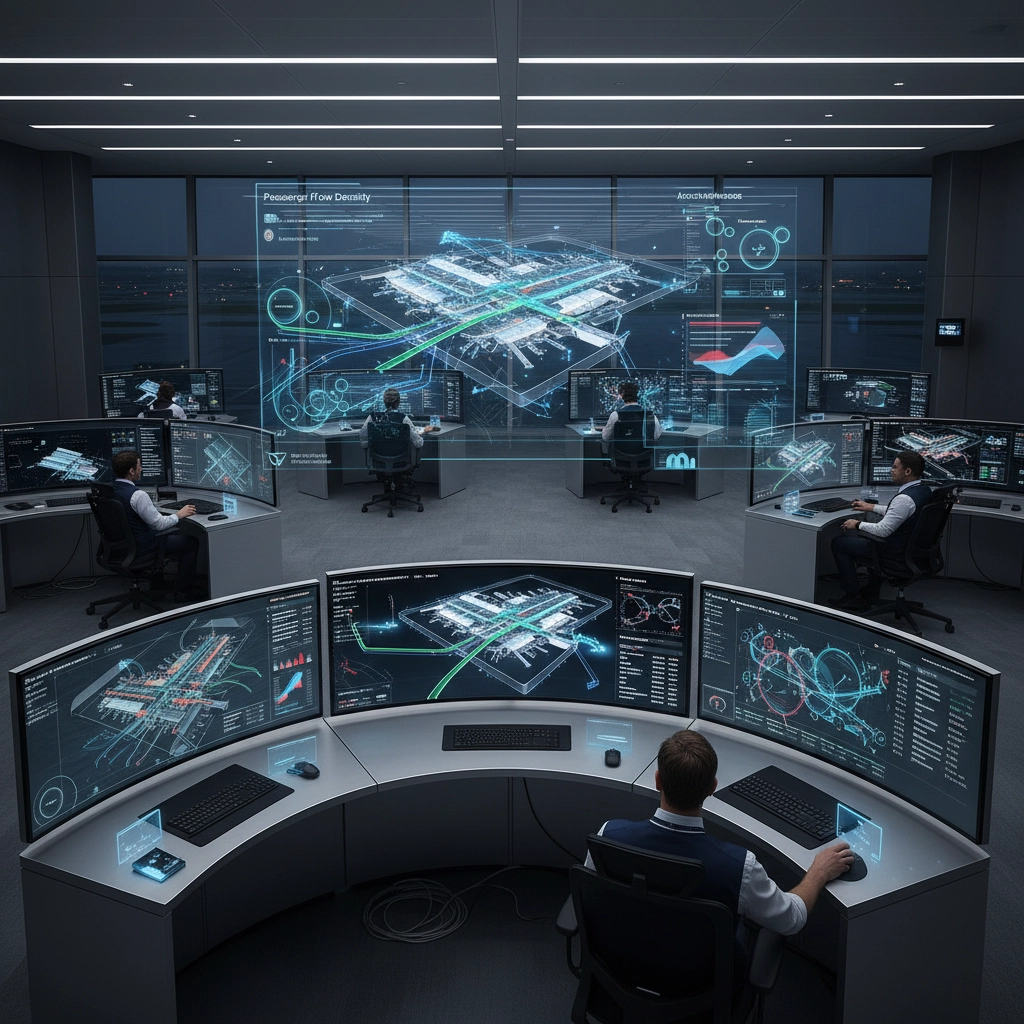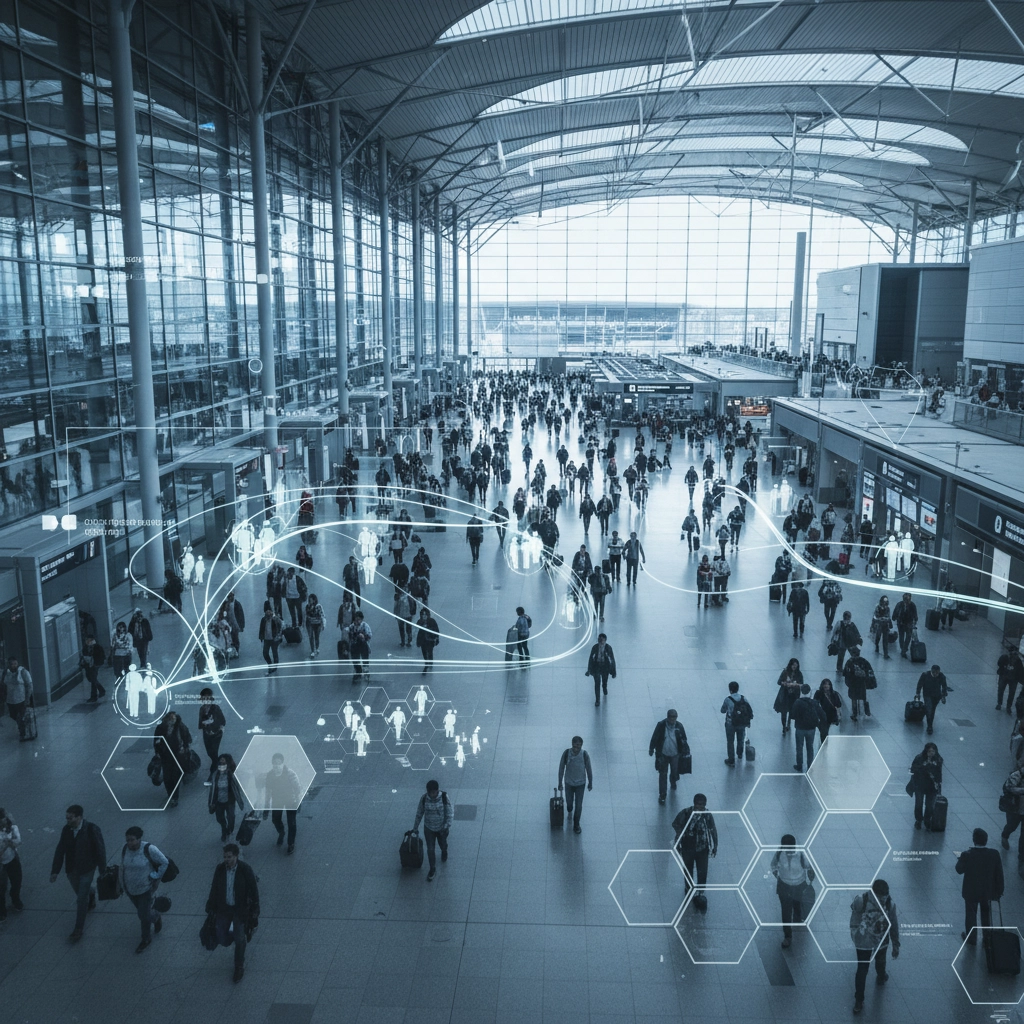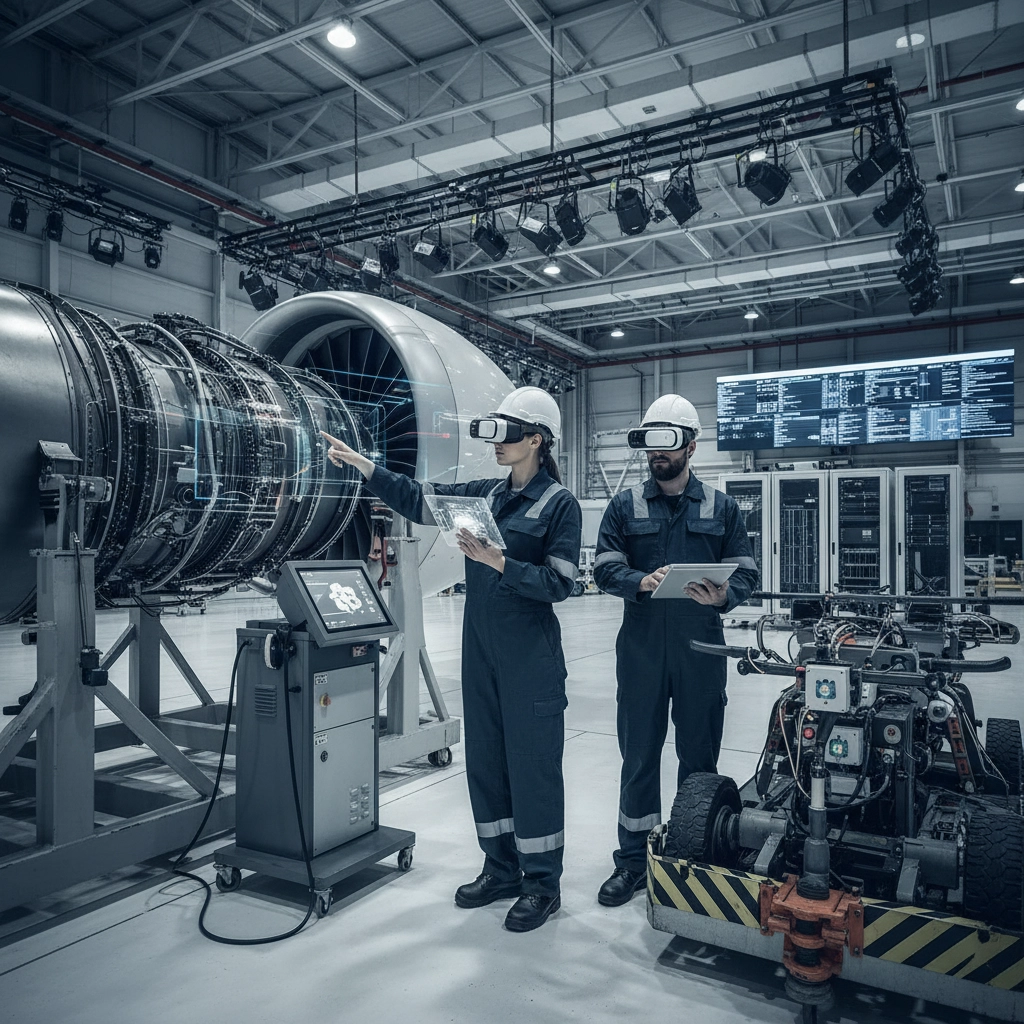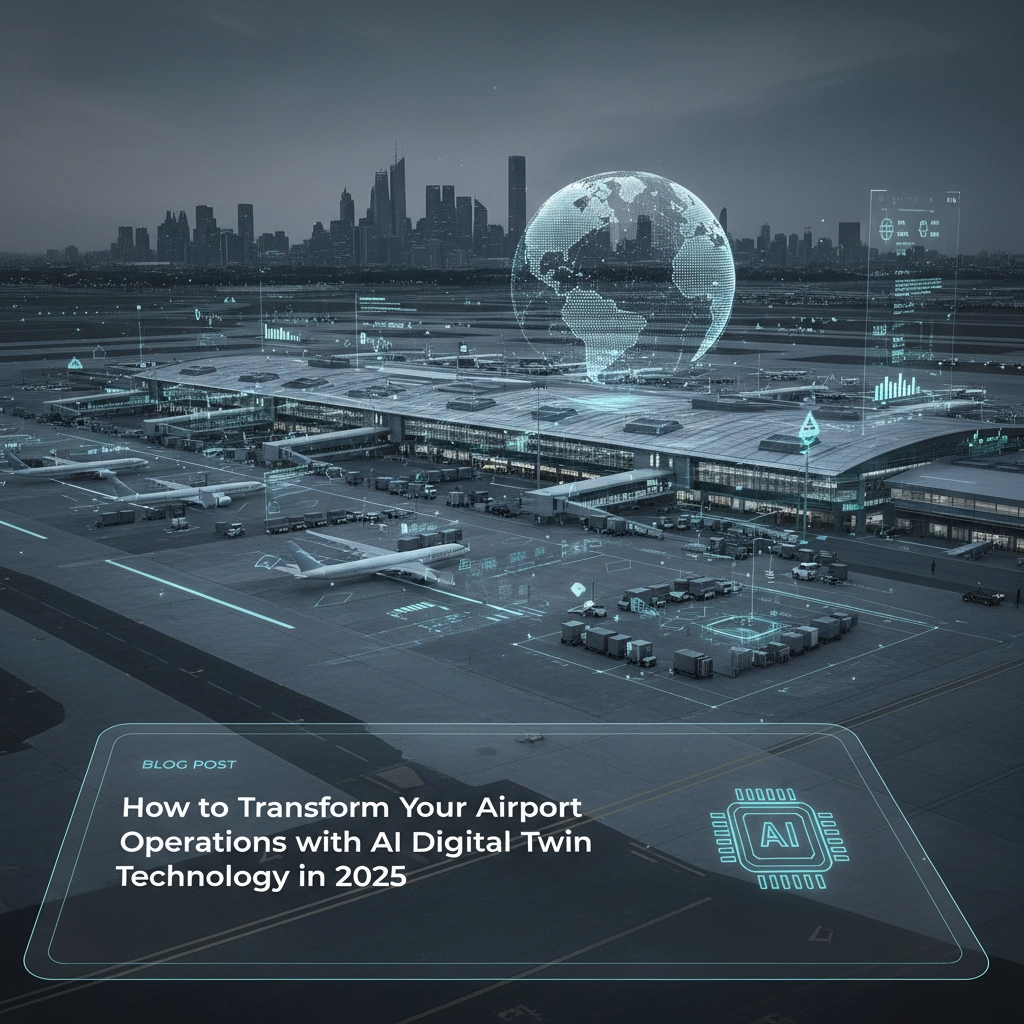The aviation industry stands at a pivotal moment. With passenger volumes rebounding and operational complexity increasing, airports worldwide are discovering that traditional management approaches simply can't keep pace. The solution? AI-powered digital twin technology that transforms reactive operations into predictive, intelligent ecosystems.
Digital twins represent more than just technological advancement: they're the foundation for a fundamental shift in how airports operate, serve passengers, and manage resources in 2025.
Understanding AI Digital Twins for Airport Operations
AI digital twins create real-time virtual replicas of your entire airport ecosystem. These sophisticated systems integrate data from IoT sensors, cameras, operational databases, and external sources to build living, breathing simulations of your facilities, processes, and passenger flows.
Unlike static modeling tools, AI digital twins continuously learn and adapt. They process vast volumes of operational data through machine learning algorithms, enabling airports to monitor performance, conduct predictive analysis, and forecast how changes will impact the entire operation before implementation.
The core components include:
- Real-time data integration from all airport systems
- Predictive analytics powered by artificial intelligence
- Scenario planning and simulation capabilities
- Automated decision support and optimization
- Integration with IoT, 5G networks, and augmented reality systems

Key Transformation Areas That Drive Results
Predictive Operations Management
Traditional airports react to problems as they occur. AI digital twins enable you to anticipate and prevent issues before they impact operations. The system analyzes historical patterns, current conditions, and external factors to predict flight delays, gate conflicts, and resource bottlenecks with remarkable accuracy.
Immediate benefits include:
- 30-40% reduction in unexpected delays through proactive scheduling adjustments
- Optimized aircraft turnaround times based on real-time resource availability
- Dynamic staffing allocation that responds to predicted passenger volumes
- Early warning systems for weather-related disruptions
Equipment and Infrastructure Optimization
Airport infrastructure represents massive capital investments that must perform reliably 24/7. AI digital twins provide unprecedented visibility into equipment performance, enabling predictive maintenance strategies that maximize uptime while controlling costs.
The technology monitors everything from baggage handling systems to HVAC equipment, escalators, and jet bridges. Machine learning algorithms identify performance patterns that indicate potential failures, allowing maintenance teams to address issues during planned maintenance windows rather than emergency situations.
Passenger Experience Enhancement
Modern travelers expect seamless, personalized experiences. AI digital twins analyze passenger movement patterns, queue lengths, and service utilization to optimize facility layouts and staffing in real-time.
During disruptions, the system instantly models alternative scenarios: rebooking passengers, reallocating gates, or rerouting foot traffic: while maintaining service quality and minimizing passenger frustration.

Implementation Strategy for Airport Digital Twins
Phase 1: Process Monitoring and Data Foundation
Begin your transformation by implementing digital twins for critical process monitoring. Focus on high-impact areas like baggage handling, security checkpoints, and gate operations where real-time visibility delivers immediate value.
Essential first steps:
- Deploy IoT sensor networks across key operational areas
- Integrate existing systems (flight information, security, maintenance) into the digital twin platform
- Establish performance metric baselines and automated alerting thresholds
- Train operational teams on digital twin interfaces and interpretation
Phase 2: Predictive Analytics and Scenario Planning
Once your data foundation is established, activate predictive capabilities that transform operations from reactive to proactive. This phase focuses on "what-if" analysis and optimization recommendations.
Key capabilities to implement:
- Predictive maintenance models for critical equipment
- Passenger flow forecasting and congestion management
- Resource allocation optimization based on predicted demand
- Emergency response scenario planning and automated protocols
Phase 3: Advanced AI Integration and Automation
The final phase leverages advanced AI capabilities for automated decision-making and continuous optimization. This includes computer vision for aircraft servicing monitoring, automated gate assignment, and intelligent resource scheduling.

Technology Requirements for Success
AI-Powered Computer Vision Systems
Deploy computer vision technology throughout your operation to monitor aircraft servicing activities, baggage handling processes, and passenger flows. These systems provide real-time feedback on operational efficiency and automatically identify deviations from standard procedures.
Computer vision integration enables faster aircraft turnaround times by monitoring fueling, cleaning, and maintenance activities while ensuring compliance with safety protocols.
Private 5G Network Infrastructure
Digital twin systems require high-bandwidth, low-latency connectivity to function effectively. Private 5G networks provide the reliable foundation needed for real-time data processing and advanced applications like augmented reality wayfinding systems.
The network supports seamless connectivity across all airport zones, enabling mobile applications, IoT device communication, and real-time collaboration between operational teams.
Comprehensive IoT Sensor Deployment
Success depends on comprehensive data collection across all airport systems. IoT sensors monitor environmental conditions, equipment performance, passenger movements, and resource utilization: feeding continuous data streams into your digital twin platform.
Critical sensor categories include:
- Environmental monitoring (temperature, air quality, noise levels)
- Equipment performance and vibration analysis
- Passenger counting and flow measurement
- Energy consumption and utility monitoring
- Security and safety system integration
Measuring ROI and Operational Benefits
Cost Reduction Through Predictive Maintenance
Predictive maintenance capabilities typically reduce equipment maintenance costs by 25-30% while extending asset lifecycles. By identifying potential failures before they occur, airports avoid costly emergency repairs and minimize operational disruptions.
The system also optimizes maintenance scheduling, allowing teams to coordinate repairs during low-traffic periods and reduce the impact on passenger operations.
Energy Management and Sustainability
Digital twins provide granular visibility into energy consumption patterns across your facility. The technology identifies inefficiencies, tests optimization strategies virtually, and tracks progress toward sustainability goals.
Environmental benefits include:
- 15-20% reduction in energy consumption through optimized HVAC and lighting systems
- Real-time monitoring of carbon footprint and emissions tracking
- Scenario testing for renewable energy integration projects
- Waste reduction through optimized resource allocation
Enhanced Passenger Satisfaction
Improved operational efficiency directly translates to better passenger experiences. Digital twins enable smoother passenger flows, reduced wait times, and more personalized services that increase satisfaction scores and encourage repeat business.

Future-Ready Airport Operations
The airports that thrive in 2025 and beyond will be those that embrace comprehensive digital transformation. AI digital twins represent the foundation for intelligent operations that adapt to changing conditions while delivering consistent, high-quality passenger experiences.
Competitive advantages include:
- Ability to handle increasing passenger volumes without proportional infrastructure investment
- Reduced operational costs through automation and optimization
- Enhanced safety and security through predictive monitoring
- Improved collaboration between airlines, ground handlers, and airport operations
- Faster adaptation to regulatory changes and industry standards
As computing power continues to advance and implementation costs decrease, digital twin technology becomes increasingly accessible for airports of all sizes. The question isn't whether to implement this technology: it's how quickly you can begin the transformation.
Building Your Digital Twin Strategy
Success requires a strategic approach that aligns technology implementation with operational goals and stakeholder needs. Start with high-impact use cases that demonstrate clear value, then expand capabilities systematically across your entire operation.
The most successful implementations combine technical excellence with change management, ensuring operational teams understand and embrace the new capabilities. Focus on training, communication, and gradual implementation that builds confidence and competency over time.
Digital twin technology offers airports the opportunity to fundamentally reimagine operations for the digital age. The airports that act decisively today will establish competitive advantages that compound over time, delivering better outcomes for passengers, airlines, and stakeholders.
Ready to explore how AI digital twins can transform your airport operations? The future of aviation begins with intelligent, predictive management systems that turn data into actionable insights and operational excellence.
